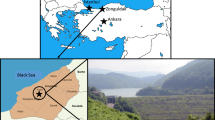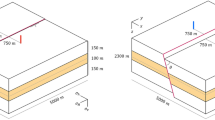Abstract
The importance of underground structures in transportation and utility networks makes their vulnerability to earthquakes a sensitive issue. Underground facilities are usually less vulnerable to earthquakes compared to above-ground structures, but the associated risk may be relevant, since even a low level of damage may affect the serviceability of a wide network. Seismic analysis of tunnels close to seismogenic faults is a complex problem, which is often neglected at the design stage for the lack of specific codes or guidelines for the design of underground structures in seismic conditions and also because, as mentioned above, underground structures are considered less vulnerable to earthquake loading. This paper investigates the seismic response of deep tunnels focusing on the required steps for a proper design under both static and dynamic loading. The study aims at contributing to improve the methods currently used for the seismic analysis of underground structures. At this purpose, the seismic response of a deep tunnel in Southern Italy has been investigated along the transversal direction. The infrastructure is part of the railway switch line connecting Caserta to Foggia in the Southern Apennines which is one of the most active seismic regions in Italy. The seismic response in the transversal direction has been analysed by using the pseudo-static approach as well as through advanced numerical modeling using the spectral element method coupled with a kinematic approach for finite fault simulations. The pseudo-static approach has been implemented using a closed-form analytical solution. The results obtained from advanced numerical modeling and the pseudo-static method have been compared to assess their validity and limitations.
Similar content being viewed by others
References
Abrahamson NA (2003) Model for strains for transient ground motion. In: Proceedings of the workshop on the effects of earthquake-induced transient ground surface deformations at-grade improvements. CUREE. N. EDA-04, Oakland, CA, USA. http://www.curee.org/projects/EDA/docs/CUREE-EDA04.pdf
AFPS/AFTES (2001) Earthquake design and protection of underground structures
Ates Y, Bruneau D, Ridgway WR (1995) An evaluation of potential effects of seismic events on a used fuel disposal fault. AECL TR-623 86 p, AECL
Barla G, Caruso G, Rondini G (1986) La problematica delle gallerie nel raddoppio della linea ferroviaria Caserta-Foggia. Congresso internazionale su grandi opere sotterranee, Firenze, Italy
Barton N (1984) Effects of rock mass deformation on tunnel performance is seismic regions. Adv Tunn Tech Subsurf Use 4: 89–99
Bielak J, Loukakis K, Hisada Y, Yoshimura C (2003) Domain reduction method for three-dimensional earthquake modeling in localized regions part I: theory. BSSA 93(2): 817–824
Bray JD, Rodriguez-Marek A (2004) Characterization of forward-directivity ground motions in the near fault-region. Soil Dyn Earthq Eng 24: 815–828
Corigliano M, Scandella L, Barla G, Lai CG, Paolucci R (2007) Seismic analysis of deep tunnels in rock: a case study in Southern Ital. In: 4th international conference on earthquake geotechnical engineering. Paper 1616
Corigliano M (2007) Seismic response of deep tunnels in near-fault conditions. PhD dissertation, Politecnico di Torino, Italy, p 222
Corigliano M, Lai CG, Barla G (2006) Seismic response of rock tunnels in near-fault conditions. In: 1st European conference on earthquake engineering and seismology. September 3–8, Geneva, Switzerland, Paper 998
Cotton F, Scherbaum F, Bommer JJ, Bungum H (2006) Criteria for selecting and adjusting ground-motion models for specific target regions: application to Central Europe and rock sites. J Seismol 10: 137–156
DISS v. 3.0.3 (2006) Database of individual seismogenic sources: a compilation of potential sources for earthquakes larger than M 5.5 in Italy and surrounding areas. http://www.ingv.it/DISS/
Einstein HH, Schwartz CW (1979) Simplified analysis for tunnel support. J Geotech Eng Div 105: 499–518
Erdik M (2000) Report on 1999 Kocaeli and DŸzce (Turkey) earthquakes. In: Proceedings of the second Euroconference on global change and catastrophe risk management: earthquake risks in Europe, Laxenburg, Austria. Reference: http://www.iiasa.ac.at/Research/RMS/july2000/Papers/erdik.pdf
Eurocode 8 (2004) Design of structures for earthquake resistance. Part 1: general rules, seismic actions and rules for building. EN 1998-1, December 2004, Comité Européen de normalisation, Brussels
Faccioli E, Maggio F, Paolucci R, Quarteroni A (1997) 2D and 3D elastic wave propagation by a pseudo-spectral domain decomposition method. J Seismol 1: 237–251
Faccioli E, Vanini M, Paolucci R, Stupazzini M (2005) Comment on “Domain reduction method for three-dimensional earthquake modeling in localized regions, part I: theroy,” by J. Bielak, K. Loukakis, Y. Hisada, and C. Yoshimura, and “part II: verification and applications,” by C. Yoshimura, J. Bielak, Y. Hisada, and A. Fernández. Bull Seism Soc Am 95(2):763–769
Hashash YMA, Hook JJ, Schmidt B, Yao JIC (2001) Seismic design and analysis of underground structures. Tunn Undergr Space Technol 16: 247–293
Hashash YMA, Park D, Yao JIC (2005) Ovaling deformations of circular tunnels under seismic loading, an update on seismic design and analysis of underground structures. Tunn Undergr Space Technol 20: 435–441
Hisada Y, Bielak J (2003) A theoretical method for computing near fault ground motion in a layered half-spaces considering static offset due to surface faulting, with a physical interpretation of fling step and rupture directivity. Bull Seism Soc Am 93(3): 1154–1168
Improta L, Iannaccone G, Capuano P, Zollo A, Scandone P (2000) Inferences on the upper crustal structure of Southern Apennines (Italy) from seismic refraction investigations and subsurface data. Tectonophysics 317: 273–297
ISO 23469 (2005) Bases for design of structures—seismic actions for designing geotechnical works
Itasca: (2005) FLAC (Fast Lagrangian analysis of continua): user’s guide. Itasca Consulting Group, Inc., Minneapolis
Kontoe S, Zdravkovic L, Potts DM, Menkiti CO (2008) Case study on seismic tunnel response. Can Geotech J 45: 1743–1764
Lunardi P, Bindi R (2004) The evolution of reinforcement of the advanced core using fibre-glass elements. FELSBAU J Eng Geol Geomech Tunn 4: 8–19
Newmark NM (1967) Problems in wave propagation in soil and rocks. In: Proceedings of the international symposium on wave propagation and dynamic properties of earth materials. University of New Mexico Press, pp 7–26
NTC—Norme Tecniche per le Costruzioni—DM 14/01/2008
O’Rourke MJ (2003) Buried pipelines, earthquake engineering handbook charter 23. CRC Press, Boca Raton
Oreste PP (1999) Aspetti notevoli dell’analisi e dimensionamento dei sostegni di gallerie. Gallerie e opere in sotterraneo
Panet M (1995) Le Calcul des Tunnels par la Méthode Convergence-Confinement. ENPC, Paris
Paolucci R, Pitilakis K (2007) Seismic risk assessment of underground structures under transient ground deformations. In: Earthquake geotechnical engineering, 4th international conference on earthquake geotechnical engineering—invited lectures, Thessaloniki, Greece. Springer, Berlin, pp 433–459
Paolucci R, Smerzini C (2008) Earthquake-induced transient round strains from dense seismic networks. Earthq Spectra 24(2): 453–470
Penzien J (2000) Seismically induced racking of tunnel linings. Earthq Eng Struct Dyn 29: 683–691
Scandella L, Paolucci R (2010) Earthquake induced ground strains in the presence of strong lateral soil heterogeneities. Bull Earthq Eng. Published on line, 23 May 2010
Scandella L (2007) Numerical evaluation of transient ground strains for the seismic response analysis of underground structures. PhD Thesis, Politecnico di Milano
Stupazzini M, Paolucci R, Igel H (2009) Near-fault earthquake ground motion simulation in the Grenoble Valley by a high-performance spectral element code. Bull Seismolog Soc Am 99(1): 286–301
Stupazzini M, Paolucci R, Scandella L, Vanini M (2006) From the seismic source to the structural response: advanced modelling by the spectral element method. In: 1st European conference of earthquake engineering and seismology, Genève, September 2006
Wang JN (1993) Seismic design of tunnels: a state-of-the-art approach. Parsons Brinckerhoff Quade e Douglas, Inc., New York, Monograph 7
Zerva A (2003) Transient ground strains: estimation, modeling and simulation. In: Workshop Proceedings on the effect of earthquake-induced transient ground surface deformations on at-grade improvements, May 28 2003, Oakland, CA, USA
Author information
Authors and Affiliations
Corresponding author
Rights and permissions
About this article
Cite this article
Corigliano, M., Scandella, L., Lai, C.G. et al. Seismic analysis of deep tunnels in near fault conditions: a case study in Southern Italy. Bull Earthquake Eng 9, 975–995 (2011). https://doi.org/10.1007/s10518-011-9249-3
Received:
Accepted:
Published:
Issue Date:
DOI: https://doi.org/10.1007/s10518-011-9249-3




